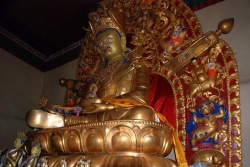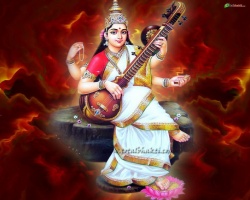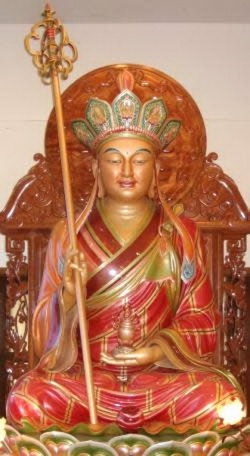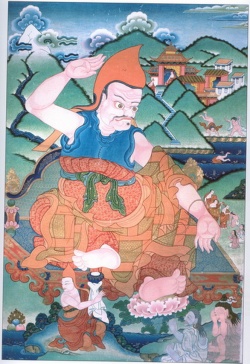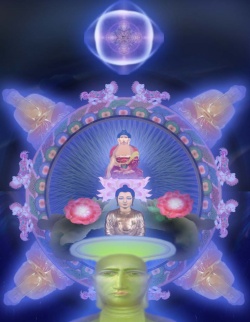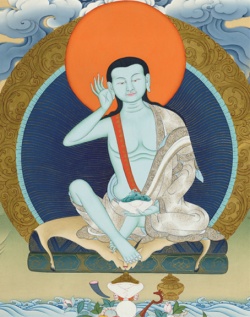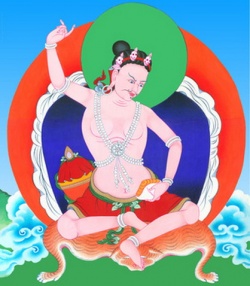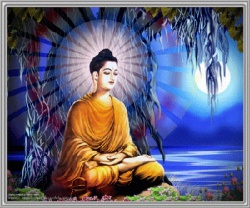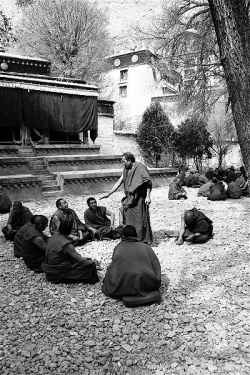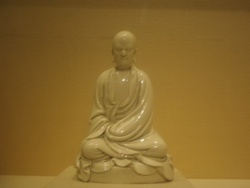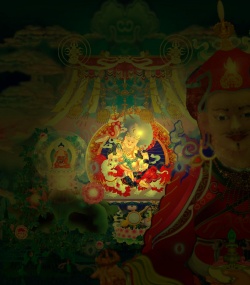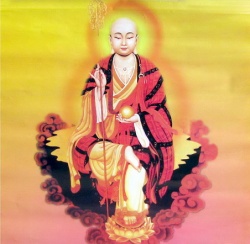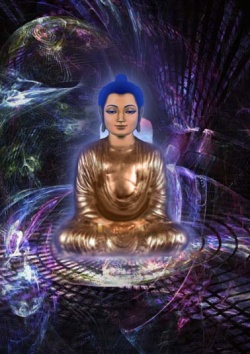Review of Indian Esoteric Buddhism, by Ronald M. Davidson
David Gordon White, University of California, Santa Barbara
JIATS, no. 1 (October 2005), THL #T1223, 11 pp.
© 2005 by David Gordon White, IATS, and THL
Ronald M. Davidson, Indian Esoteric Buddhism: A Social History of the Tantric Movement. New York: Columbia University Press, 2002. 475 pp., 23 b & w, 4 maps. $62.50 hard; $24.50 paper.
Early in this groundbreaking, sprawling work, Ronald Davidson evokes the image of the epic hero Bhīṣma, “skewered so completely by Arjuna’s arrows that he rests not on the ground but on the protruding tips of the arrows.”
1 Such is my copy of Indian Esoteric Buddhism, which bristles not with arrows, but with hundreds of post-its, whose yellow tongues speak volumes on the originality of this study,
whose density of compelling insights per page is quite unrivalled in the history of scholarship on a subject which, it must be allowed (and here I allow myself to mix metaphors), is as difficult to comprehend as the plot of a David Lynch movie.
In this, Davidson’s work is the most impressive effort to date in the very short history of scholarly attempts to afford a comprehensive view of the history of Buddhist Tantra on the ground as well as in texts.
Geoffrey Samuel’s Civilized Shamans 2 and the late Michel Strickmann’s Mantras et Mandarins are both outstanding works on the comparable socio-political histories of Buddhist Tantra in Tibet and China,
respectively, but it must be allowed that these authors were not required, as Davidson was for medieval India, to first piece together the political histories undergirding the religious history that was the object of their scholarship.
In the case of medieval India, since there was no “standard” imperial historiography to take as a framework upon which to construct a religious history, Davidson’s first task was to piece together that socio-political history.
This would explain, I believe, “why,” as Davidson wonders out loud in his preface (xi), “such a work has not yet been attempted, nor…why it took me as long as it did [to write].”
On the first page of his preface (xi) and in his opening chapter, Davidson addresses the principal reasons, from the perspective of the sociology of knowledge, for why such a work had not previously been attempted,
these being the reigning scholarly fashions of “insider” scholarship by Buddhist practitioners on the one hand and, on the other, the equally doctrinaire theoretical approaches that have held the humanities and social sciences fields for well over two decades,
both of which reject out of hand the validity of the critical historical method, the one because it is critical and the other because it is historical.
Both of these scholarly orthodoxies – coupled with the vitiating theories of Max Müller, James Frazer, and the Pāli Text Society with their essentialist notions of the pristine origins and subsequent decay of every religion – are symptomatic of a failure of nerve of sorts.
In the first case, the confessional approach to Buddhism assumes its truths to be eternal and unchanging, and therefore not subject to historical scrutiny.
This limits the purview of the scholar to establishing critical readings of texts, elaborating standard iconographies, and discussing the technical aspects of ritual and practice (by relying, in the main, on an erudite commentarial tradition) as so many facets of a pristine spirituality not grounded in the real world.
But spirituality is not practice, and the scope of religion extends beyond people’s minds, even in a tradition whose doctrine maintains that everything is in the mind.
So, for example, the uncritical notion that the Indic Vinaya texts provide a complete picture of the Buddhist religious system is untenable, because Buddhist monasteries were never hermetically sealed and isolated from the outside world, but were rather intensified microcosms of that very world in which they dwelt (24).
The second reigning orthodoxy, postmodernism in its poststructuralist and post-colonialist forms, rejects on ideological grounds the validity of the historical enterprise, by denying, on the premise that the very concept of history is Eurocentric, the objective validity of any attempt to describe the past on the basis of historical data.
The result is that critical theorists are reduced to talking about themselves talking about themselves, which has the dual advantage of not offending the essentialized Subalterns whom the same theorists will never have to meet, and [page 3] of sparing said theorists the need to learn foreign or ancient languages, to carry out research in the field,
or to undertake the detective work that is the hallmark of conscientious (but not self-conscious or self-reflexive) historical scholarship.
The principal disadvantage for scholars who embrace this orthodoxy is that it inhibits historical investigation, and, for that matter, any opening to the other whatsoever.
The core of Davidson’s central argument is that esoteric Buddhism was a direct Buddhist response to the feudalization of Indian society in the early medieval period (ca. 500-1200 CE), a response that involved the sacralization of much of that period’s social world.
The symmetry of his argument is at once elegant and compelling: the early medieval period that saw the apotheosis of kings who assumed the positions of divinities or their incarnations and manifestations also saw the feudalization of divinity, wherein the gods (or divinized buddhas) became perceived as warlords and as the rulers of the earth (26).
Eo ipso, the monk or yogin in the esoteric system reconfigured his own practice through the metaphor of becoming the overlord of a maṇḍala of vassals, with issues of scripture, language, and community reflecting the political and social models employed in the surrounding feudal society (2).
This argument is developed particularly in chapters three and four, with chapters two and three outlining the principal historical and sociopolitical causes for the breakdown of the prevailing Mahāyāna system of Buddhist polity, and chapter four the forms that the new institutional esotericism took.
It is in these chapters that Davidson is at his best, as he simultaneously develops a number of historical arguments to delineate the specificity of Buddhist Tantra in its South Asian contexts, contexts that were at once social, economic, political, and religious.
His core argument maintains that following the breakup of the Gupta imperial formation, datable to the death of Harṣavardhana in 647 CE, the traditional sources of patronage for Buddhist institutions – the merchant guilds and imperial houses – also began to collapse.
In the six rough and tumble centuries that followed, in which military and political adventurism, sāmanta-feudalism, Hindu Tantric orders and sects, and Islamic incursions from the west were on the rise, the esoteric turn within Buddhism was a strategy – that ultimately failed, given the fact that Buddhism effectively disappeared from the subcontinent by the end of the twelfth century – to adapt to the new Realpolitik.
The historical irony of this situation, as Davidson repeatedly notes, is that while the esoteric turn did not save the sinking ship of Buddhism in India, it made it highly attractive as an export commodity, which succeeded in penetrating into China, Tibet, Nepal, and Inner Asia, where Buddhism continues to flourish, often in an esoteric mode.
Davidson’s ancillary arguments, grounded in the assumption that religion is a human creation that projects a divine world rather than the opposite, are multifaceted and extremely insightful.
These include: a radical change in the tone of medieval panegyrics, toward an idealization of warfare and the apotheosis of kingship, leading to a combination of the heroic and erotic tropes that became the hallmark of much of Tantric expression (69, 87-89);
the feudalization of the divine pantheon, with the imperial divinity favored by an overlord becoming the divine overlord for the family and village deities worshiped by the monarch’s vassals (71);
an [page 4] explosion in temple construction (paralleling an explosion in the production of “unauthorized” scripture), with the efflorescence of regional styles in architecture and sculpture reflecting a fragmentation of imperial power and authority (73);
the replacement of Buddhist stūpa consecration and Brahmanic Śrauta rituals with Puranic coronation ceremonies, which privileged high Hindu gods over the Buddha or the efficacy of the old Vedic rites (84-85); “elective affinities” between Śaiva values and rhetoric and the goals and needs of militaristic princes (“Śiva…was, after all, a killer divinity with a permanent erection”: 90),
leading to a shift in patronage patterns away from Buddhist institutions toward Hindu sectarian groups, resulting in turn in a defensive strategy on the part of Buddhist monks to conform to the dominant Hindu paradigm of varṇāśrama dharma,
the affirmation of caste and the stages of life, as well as in a sharp decline in women’s participation in the medieval Buddhist public sphere (91-98);
the translation of a loss of institutional support into the abandonment of Buddhism-specific philosophical categories, doctrines, and nomenclature, as well as the rise of skepticism and epistemology as philosophical tropes (99-105);
and the ruralization of the medieval power base, resulting in the vassalization of the so-called Buddhist monastery-universities into institutions that supported the feudal monarchs of the period both materially and through “magical performance” (105-111).
Chapter four, which contains the most original and compelling insights of the entire book, is devoted to the institutionalized Buddhist esotericism of the Mantrayāna, which most fully incorporated the imperial metaphor,
the expressions of which are found in the emerging canon of the Yoginī Tantras in particular. Here, the argument is skillfully developed that from the early eighth century onward,
Buddhist institutions adapted to the new political realities of medieval India by contracting into regions of strength and into edifices mimicking feudally grounded fortresses, and in behaviors that mirrored the activities of the kings they cultivated (167).
Mantrayāna Buddhism, which was simultaneously the most politically involved of Buddhist forms and the variety of Buddhism most acculturated to the medieval Indian landscape, embodied the “imperial metaphor” of the practitioner becoming an overlord (rājādhirāja) of the universe (114).
This it did in a number of ways that reflected the prevailing political ideologies of the period, as it internalized, appropriated, reaffirmed, and rearranged the structures most closely associated with the systems of power relations, ritual authentication, aesthetics, gift-giving, clan associations, and the sense of dominion that defined post-Gupta Indian polities.
While this reorientation and embrace of the new paradigms of power was not monolithic or orchestrated from some centralized Buddhist authority – because none existed – it was nonetheless pervasive: it was an ideology consciously and unconsciously adopted by a multiplicity of regional institutional cultures (115-116).
Most striking, as Davidson demonstrates, is the bivalency or paronomasia of several sets of terms bearing religious as well as military and political significations, the most remarkable example of such being the terminology of royal and monastic consecration, in which the terms abhiśeka, maṇḍala, kula, mantrin, etc. are applied, [page 5] in congruent and mutually informing ways, to both realms (122).
So too, the configurations of esoteric Buddhist maṇḍalas, such as the Trailokyavijaya maṇḍala (138) or Kukura’s enactment of the Vajradhātu maṇḍala (243), appear to derive explicitly from medieval models of polity, in which divine kings ruled from the centers of circles of interrelated families, vassals, allies, and enemies whose boundaries were in constant flux.
Once again, religious maṇḍalas are seen to be so many Buddhist attempts to sanctify existing public life and recreate the meditator as the controlling personage in the topsy-turvy world of Indic feudal practice (131), which, following Chattopadhyaya, Davidson identifies as “sāmanta-feudalism” (137).
This is mirrored in esoteric Buddhist practice, in which the placing of one’s chosen (through the casting of a flower) adamantine buddha at the center of a maṇḍala sets up an immediate ripple effect of overlord-vassal relations with all of the buddhas of surrounding maṇḍalas (139).
Furthermore, the very terminology of the geometric components of the maṇḍalas themselves – with their central palaces (kūṭāgāras) opening into arched gateways (toraṇas), protected by adamantine redoubts (vajra-pañjaras) and so on – appear to derive directly from medieval citadel-palace architecture (140).4
While Davidson’s reconstruction of institutional, monastic Buddhism’s political, social, and hermeneutical strategies for survival in the brave new world of medieval India is extremely insightful and convincing, his anthropology of less institutionalized figures within or on the fringes of the Buddhist fold, as well as his assessment of medieval Buddhism’s “others” –
the various Hindu (mainly Śaiva) orders with which it was in direct competition on the one hand, and the marginal peoples whom he terms “tribals” on the other – are somewhat less satisfying.
These are the subjects of chapters five, six, and seven, which while they are remarkable for their sheer volume of original data and thoughtful analysis, are nonetheless less convincing, if only for Davidson’s use of terminology.
In the balance of this review, I will concentrate on his use of five terms (kula, “tribal,” siddha, Pāśupata, and Kāpālika), which he links together to form many aspects of his argumentation.
Here, I will bring my understandings as a specialist of medieval Hindu Tantra to bear on Davidson’s analyses, which are quite often based on Hindu materials in these final chapters.
If, as Davidson asserts for medieval Buddhism, the term kula connotes a set of specific spatial or geographic relations (140-41), such was not the case for medieval Hindu Tantra, in which the notion of family or clan lineage, or of simply belonging to an aggregate, whether biologically determined or voluntary, is emphasized.5
What is essential in the concept of kula are family relations in genealogies that flow from the supreme godhead down through families of often female divinities, and ultimately to lineages of gurus and disciples, in whose number would have been included the royal patrons of the Tantric specialists.
Rather than being [page 6] geographically situated, as Davidson argues, their positioning was more a matter of location within a nexus of family and marriage relations.
Here as well, there is a symmetry between human and divine hierarchies, with family ties between a king and his queen’s extended family often serving to consolidate the former’s power base, as much as did his military exploits.
The importance of lineage deities (kula-devatās), and particularly lineage goddesses (kula-devīs) cannot be overestimated here, since it was often through the adoption of his queen’s clan goddess that a king became symbolically wed to the land itself.6
It is here that ground-level maṇḍalas of royal power intersect ideal or virtual maṇḍalas of divine influence, since at the local level, grāmadevatās, the divinities that embody and protect human settlements, have always been goddesses (albeit often accompanied by male “protectors of the field,” kṣetrapālas and “scarecrows,” bhairavas).
These networks of family and local deities are always already there before any translocal, transcendental, imperial system becomes superimposed upon it. And indeed, the ancestors of the myriad families of buddhas, Hindu high gods, ḍākinīs, yoginīs, and so on are none other than the kula-devatās and grāmadevatās of pre-Mahāyāna and pre-bhakti Indian polytheism.
A telling example from Buddhist Tantra is Vajrapāṇi, whose epithets or titles include Yakṣasenādhipati (“general of the Dryads”) and guhyakādhipati (“Lord of the Mysterious Beings”) (143).
Yakṣas and guhyakas are but two of the myriad aggregates that formed the host (gaṇa) of divinities of South Asian polytheism, and the lower ends of the pantheons of Tantric gods are simply continuations of these aggregates, whose textual pedigrees go back to the Hindu Atharva Veda.
Indeed, when the high gods of Hinduism begin to emerge out of these family, local, and regional traditions, they are first described in such Buddhist sources as the Mahāmāyurīvidyārājñī as the yakṣas of specific locales:
Viṣṇu is the yakṣa of Dvaraka; Kārttikeya that of Rohiṭaka (ṛohtak, in present-day Hariyana); Arjuna that of Arjunāvana; Garuḍa that of Vipula; Maheśvara the yakṣa of the Virāṭas; Mahākāla that of Varanasi; Śiva that of Śivapurahara, and so on.7
The foregoing discussion leads to a reassessment of the term “tribal,”8 as used by Davidson throughout the later chapters of his book.9
This is, of course, an etic term, employed by urban elites (mainly Brahmins) and monastic literati – the [page 7] authors of the texts that scholars rely upon for much of their historical data – and not one that the “signifieds” of the term would have applied to themselves.
The complex interplay between outsiders and insiders that is part and parcel of the processes of sanskritization and parochialization is one that has been ongoing since the original contacts between the nomadic people of the Vedas and the indigenous peoples they encountered as they moved into the Indian subcontinent.
It is therefore more useful, I believe, to speak in terms of “local” and “translocal” traditions in the way that Richard Cohen has done in his brilliant study of Buddhist imagery at Ajanta.10
In other words, one need not invoke such distant others (as construed through brahmanic or monastic discourse) as tribals to describe the appropriation of local or vernacular religious tropes, on the one hand because to do so sets up a false dichotomy between the translocal and local cultures;
and on the other, because doing so requires a great deal more explanation than necessary for such troubling facts as the absence of a great goddess figure in “tribal” Saora (Śabara) religion (232), or the improbability of tribals being able to construct yoginī temples in stone (181).
What we have in the medieval textual data at our disposal are by and large elite Sanskritic imaginings of local vernacular traditions (229),
which in the case of medieval Tantra often romanticized and idealized the “forest life” of “tribals” in the same way that urban elites imagined a forest they rarely visited but often described in the Hindu Āraṇyakas (“Forest Books”) and Upaniṣads.
But in fact, much of what was imagined as “tribal” were simply local traditions, which were the same fount as that from which had sprung the local divinities of the outer frames of translocal maṇḍalas – the yakṣas, guhyakas, rakṣasas, gandharvas, bhūtas, kinnaras, siddhas, and so on – in some cases since the time of the Atharva Veda.
The same applies to elite labeling of this or that ruling house as being of śūdra, outcaste, or tribal stock.
In the light of the Manu Smṛti’s long classification of all of the peoples belonging to the fifth caste “that is not a caste”;11 as well as of the historical fact that the royal patrons of many of the early Hindu devotional sects (the Bhāgavatas, Vāsudevakas, Pāñcarātras, etc.)
were branded as barbarian mlecchas and yet given royal initiation by them,12 it is clear that such classifications were not truly binding in the real world, but rather elite hermeneutical strategies.
In this light, Davidson’s assertion that “the Chandellas of Khajuraho came from Gond tribal stock” (226) for example, is not a sufficient or even a necessary explanation for that dynasty’s embrace of Tantra.
With this, I come to the issue of the siddhas, who are listed in the fifth-century CE Amarakoṣa as one of the eight classes of demigods (devahyonayaḥ), together with the Vidyādharas (“Wizards” or “Sorcerers”) and the six classes of beings enumerated in the last paragraph.13 A few centuries prior to this lexicon, the Mahābhārata evokes the semi-divine siddhas several hundreds of times.
On the basis of these data alone, Davidson’s dual assertion that the term siddha ought to be applied solely to human practitioners, and that the goal of siddha-hood of said practitioners was not based on a (semi-) divine prototype, is untenable.
Many of the data – both Hindu and Buddhist – that he musters to demonstrate his points are interesting and new to me, but they are not sufficient to prove his exclusivist position, that siddhas were never anything other than human practitioners seeking the supernatural powers and status proper to the semidivine vidyādharas.
Furthermore, because he rejects Ruegg’s model14 of a pan-Indian religious substratum of multiple local traditions for the elite, translocal traditions of Hindu and Buddhist Tantra, he finds himself obliged,
once again, to opt for an adstratal explanation, i.e., that the siddhas or the people that inspired their heterodox discourse came from “outside” the boundaries of the South Asian “great traditions” of Buddhism and Hinduism, from tribal zones or the outcaste strata of society.
Down to the present day, one finds the term siddha (or sidh, sid, śid) used in many local or regional traditions to denote a class of multiple supernatural beings – of the same order as the semidivine or semidemonic vīrs (or bīrs or pīrs), nāths, bhairavs, or bhūtanāthas (190; 383, n. 53) –
often identified with the heroic or the demonic dead, but also with exemplary human actors who have gained supernatural powers in life, often by wresting said powers from supernatural beings, thereby becoming divinized before or after death.15
Rather than adstratal, the Tantric sources for the siddhas were substratal if not orthogenic, deriving in a straight line from pre-existing local traditions that had already become incorporated into the translocal discourse of the Hindu and Buddhist scriptures.
Finally, as Davidson acknowledges (234), the term “siddha” probably does not cover the same semantic field in Hindu Tantric scriptures as it does in Buddhist sources, with the Hindu vīra16 (the Tantric practitioner as “Virile Hero”) or yogin (“Thaumaturge”) perhaps being closer to Buddhist referents of the terms siddha and mahāsiddha.
Davidson argues eloquently for the fact that Buddhist Tantra was in many respects an unsuccessful rear-guard action on the part of Buddhist institutions to compete with Hindu tāntrikas who already had won the attention and allegiance of South Asian royal patrons.
Yet, if one agrees with his argument (and I do), contra Sanderson, that Buddhist Tantric scriptures predate Hindu Tantric scriptures [page 9] by at least one hundred years (386, n. 105), one is forced to look for other sorts of evidence for the hegemonic influence of Śaiva and Kaula17 actors in the royal courts.
Here, Davidson argues at length that the Śaiva sectarian groups known as the Pāśupatas and Kāpālikas were the prime agents of Hindu Tantric hegemony in the early medieval period. Yet, when one looks for scriptural and epigraphical evidence for the institutional existence of these two Hindu Tantric orders or sects, one finds that there is virtually no data for either. This is particularly the case with the Kāpālikas.
There are no Hindu Tantric scriptures that contain the term Kāpālika in their title,18 or whose authors call themselves Kāpālikas, and there is not a single inscription in all of South Asia that names the Kāpālikas in a way that would indicate an actual sectarian order.19
In fact, it is in Buddhist vernacular poetry alone that one finds persons referring to themselves as Kāpālikas (218), and it is perhaps for this reason that the Indian scholar Nagendra Nath Upadhyay published a book in 1983 entitled Baudha Kāpālik Sādhanā aur Sāhity.20
Ultimately there is no “there” there for the Kāpālikas as an institutionalized order or sect; and while there can be no doubt that persons wearing skulls and the other regalia of the “culture of the cremation ground” have long haunted the South Asian landscape and the “prescriptive imagination” – down to the present-day Aghoris – the evidence for their direct impact on medieval polities remains extremely limited.
Perhaps a “liminal period” in the spiritual itineraries of South Asian practitioners, perhaps a rhetorical trope (like the rhetoric of secrecy), perhaps a performative imitatio dei of the wrathful gods of Tantra, perhaps part of a complex hermeneutical strategy of disclosure and dissimulation, and very likely a stock antitype of the ideals of Hindu orthodoxy, the figure of the Kāpālikas will continue to enthuse and fascinate,21 even if its real-world referent will continue to elude us.
While there is somewhat less paucity of hard historical evidence for the Pāśupatas, the data that Davidson musters – a single scriptural source, a limited number of inscriptions, and a long list of “probable Pāśupata sites” mainly based on the presence of images of Lakulīśa, the mythical founder of the order (184, 341-343) –
is, once again, insufficient to demonstrate that this was the entrenched [page 10] Śaiva competition that the Buddhists never succeeded in supplanting in medieval South Asian systems of royal patronage.
There is, on the other hand, a great volume of evidence that, rather than the Pāśupatas, it was the Śaivasiddhānta orders, with their networks of monasteries and highly visible leaders, that were – much like their Buddhist homologues, the abbots of the great monasteries – the true (Śaiva) power-brokers of medieval India.22
It is the “orthodox Tantra” of the Śaivāgamas, the voluminous scriptural canon of the Śaivasiddhāntins, rather than the heterodox Kaula canon, that the broadest swathe of South Asian society has embraced since the end of the first millennium.
So, while it was the non-institutionalized Kāpālikas and their semi-institutionalized Pāśupata predecessors whose antinomian subcultures sparked the medieval imagination, it was the Śaivasiddhāntins who won the hearts and minds of kings, aristocrats, and householders – the great “silent majority” – throughout much of the subcontinent.
My reservations with these elements of Davidson’s arguments do not detract from my great enthusiasm for this outstanding work of scholarship. To undertake to write a social history of a protean phenomenon in a turbulent time is an act of great courage; to successfully complete it an act of great prowess, and Ronald Davidson is to be applauded for this splendid contribution to the history of religions in medieval India.
This is a book that sparkles with erudition, wit, and humor. It is a classic that will inform and inspire for many years to come.
David Gordon White University of California, Santa Barbara
[1] I take issue, however, with Davidson’s characterization (p. 63) of Bhīṣma as being “ridiculously depicted” as such by the epic compilers. On the one hand, Bhīṣma’s bed of arrows prevents him from touching the ground, which he must not do until the sun has swung around to its “northern course” on the winter solstice, which will enable the venerable hero to accede directly to the world of the gods.
On the other, as Stig Wikander (Germanische und indo-iranische Eschatologie,Kairos 2 [1960]: 83-88) and Georges Dumézil (Mythe et epopee, vol. 1, L’idéologie des trios functions dans les epopees des peoples indo-européens, 5th ed. [[[Wikipedia:Paris|Paris]]:
Gallimard, 1986], 255-57) have demonstrated, the image of a hero on a bed of arrows is an Indo-European mytheme, with parallels in the Swedish epic of the Battle of Bravallir and elsewhere.
[2] Geoffrey Samuel, Civilized Shamans: Buddhism in Tibetan Societies (Washington, D.C.: Smithsonian Institution Press, 1993). [3] Michel Strickmann, Mantras et mandarins: le bouddhisme tantrique en Chine (Paris: Gallimard, 1996). English translation forthcoming, Princeton University Press.
[4] Parpola pushes the origins of the maṇḍala back to Bactrian fortified citadels (Deciphering the Indus Script [[[Wikipedia:Cambridge|Cambridge]]: Cambridge University Press, 1997], 255-56, and figs. 14.30 and 14.31).
[5] On this, see David Gordon White, Kiss of the Yoginī: “Tantric Sex” in Its South Asian Contexts (Chicago: University of Chicago Press, 2003), 18-19. [6] White, Kiss, 20-21.
[7] Sylvain Lévi, Le catalogue des Yakṣa dans la Mahâmâyurî,Journal Asiatique 11, no. 5 (Jan - Feb. 1915: 19-138, especially 32-37, 55. Although the text was translated four times between the fourth and eighth centuries CE, the earliest version of the Mahāmāyurī in which the comprehensive list of tutelary “yakṣas” is found, dates from the fifth century CE (ibid., 20-26).
[8] Davidson’s translation of the Sanskrit term āṭavika as “tribal” is highly problematic: a derivate of the root √ aṭ, “to roam,” the term’s semantic field seems not to denote the term “tribal” so much as it does “people who roam” (in the forest – āṭavī – the “place for roaming”), a group that would include slash-and-burn cultivators and pastoralists from a multiplicity of racial, ethnic, or caste backgrounds, as well as religious mendicants.
[9] Davidson acknowledges the omnibus use of the term at page 225: “…the term ‘tribal’ has been applied to widely disparate ethnicities, including pastorialist nomad groups, semiagrarian confederacies, and the indigenous (Adivasi) people of Orissa, Assam, Madhya Pradesh and Maharastra, who have retained hunter-gatherer practices down to the present.”
[10] Richard S. Cohen, Nāga, Yakṣinī, Buddha: Local Deities and Local Buddhism at Ajanta,History of Religions 37, no. 4 (May 1998): 360-400. [11] Manu Smṛti 10.4-56.
[12] See especially Dennis Hudson, The Śrīmad Bhāgavata Purāṇa in Stone: The Text as an Eighth-Century Temple and its Implications,Journal of Vaiṣṇava Studies 3, no. 3 (Summer 1995): 146-55, with reference to Śūdra kings of Kancipuram and the Yavana (Indo-Bactrian kings of Northern India). [13] Amarakośa 1.1.11: vidyādharāpsaro yakṣarakṣo gandharvakiṃnarāḥ/ piśāco guhyakaḥ siddho bhūto ’mi devayonaya/.
[14] Here, Davidson is not well served by Alexis Sanderson, whose argument he follows, contra Ruegg, that the gods or saints of all Tantric systems are always associated with specific institutionalized lineages and traditions, and not simply free-floating forms.
This is, to be sure, the view from above of the Brahmin or Buddhist monastic scribalist, but unless one allows that that translocal viewpoint is the sole admissible perspective from which to view the phenomenon of Tantra, such an orthodox, exclusionist interpretation ought not to be applied to the multiple local sources of Tantra.
[15] Such traditions are found throughout Maharastra, as documented in Gunther-Dietz Sontheimer, Pastoral Deities in Western India, trans. Anne Feldhaus (New York: Oxford University Press, 1989), 37-38 (on Khilubā the Śid) and throughout.
[16] As Davidson notes at page 289, the term vīra is also used for Buddhist Tantric practitioners.
[17] I prefer the term “Kaula” to Śākta, since the latter, employed by Davidson, is not used as a technical term in the Tantras until the eleventh century; prior to that time, the term Kaula prevailed (Mark S. G. Dyczkowski, Kubjikā, Kālī, Tripurā and Trika,Nepal Research Center Publications 22 [Stuttgart: Fritz Steiner Verlag, 2000]: 1, n. 2.).
[18] In spite of this, Alexis Sanderson refers to an entire corpus of Kaula scriptures from Nepal as “Kāpālika Tantras,” thus inventing, albeit for heuristic purposes, a category of Tantras that never existed.
[19] None of the four inscriptions that David Lorenzen (New Data on the Kāpālikas, in Criminal Gods and Demon Devotees, ed. Alf Hiltebeitel [Albany, NY: SUNY Press, 1989], 233) identifies as referring to Kāpālikas actually names them as such. At most, they refer to the donees as wearing or carrying skulls. In this light, however, one would be obliged to find evidence for the Kāpālikas in the pre-CE Maitri Upaniṣad (7.8), which warns against “those who wear earrings and skulls” (kuṇḍalinaḥ kāpālino). For further discussion, see White, Kiss,152-53.
[20] Nagendra Nath Upadhyay, Baudha Kāpālik Sādhanā aur Sāhity (Allahabad: Smrti Prakashan, 1983).
[21] In the present-day Kathmandu Valley, for example, much of the imagery of Hindu Tantra remains “Kāpālika,” even though no Kāpālika practitioners are anywhere to be found.
[22] See especially Richard Davis, Ritual in an Oscillating Universe: Worshiping Śiva in Medieval India (Princeton: Princeton University Press, 1991); and Davis, Inscriptions of the Drunken Peacocks, in Tantra in Practice, ed. David Gordon White (Princeton: Princeton University Press, 2000), 131-45.
Source
http://www.thlib.org/collections/texts/jiats/#!jiats=/01/white/b1/

